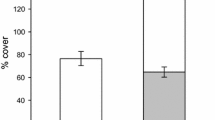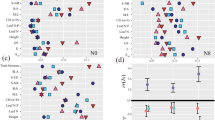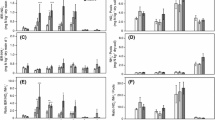Abstract
Increased resource availability and feedbacks with soil biota have both been invoked as potential mechanisms of plant invasion. Nitrogen (N) deposition can enhance invasion in some ecosystems, and this could be the result of increased soil N availability as well as shifts in soil biota. In a two-phase, full-factorial greenhouse experiment, we tested effects of N availability and N-impacted soil communities on growth responses of three Mediterranean plant species invasive in California: Bromus diandrus, Centaurea melitensis, and Hirschfeldia incana. In the first phase, plants were grown individually in pots and inoculated with sterile soil, soil from control field plots or soil from high N addition plots, and with or without supplemental N. In the second phase, we grew the same species in soils conditioned in the first phase. We hypothesized growth responses would differ across species due to species-specific relationships with soil biota, but overall increased N availability and N-impacted soil communities would enhance plant growth. In the first phase, Centaurea had the greatest growth response when inoculated with N-impacted soil, while Bromus and Hirschfeldia performed best in low N soil communities. However, in phase two all species exhibited positive growth responses in N-impacted soil communities under high N availability. While species may differ in responses to soil biota and N, growth responses to soils conditioned by conspecifics appear to be most positive in all species under high N availability and/or in soil communities previously impacted by simulated N deposition. Our results suggest N deposition could facilitate invasion due to direct impacts of soil N enrichment on plant growth, as well as through feedbacks with the soil microbial community.



Similar content being viewed by others
References
Agrawal AA, Kotanen PM, Mitchell CE, Power AG, Godsoe W, Klironomos J (2005) Enemy release? An experiment with congeneric plant pairs and diverse above-and belowground enemies. Ecology 86:2979–2989
Allen EB, Padgett PE, Bytnerowicz A, Minnich R (1996) Nitrogen deposition effects on coastal sage vegetation of southern California. In: Bytnerowicz A, Arbaugh MJ, Schilling S (tech. coords) Proceedings of the international symposium on air pollution and climate change effects on forest ecosystems, Riverside, California. General Technical Report PSW-GTR
Belnap J, Phillips SL, Sherrod SK, Moldenke A (2005) Soil biota can change after exotic plant invasion: does this affect ecosystem processes? Ecology 86:3007–3017
Bennett AE, Strauss SY (2013) Response to soil biota by native, introduced non-pest, and pest grass species: is responsiveness a mechanism for invasion? Biol Invasions 15:1343–1353
Bertrand H, Plassard C, Pinochet X, Touraine B, Normand P, Cleyet-Marel J (2000) Stimulation of the ionic transport system in Brassica napus by a plant growth-promoting rhizobacterium (Achromobacter sp.). Can J Microbiol 46:229–236
Bever JD (2002) Negative feedback within a mutualism: host-specific growth of mycorrhizal fungi reduces plant benefit. Proc R Soc Lond B Biol Sci 269:2595–2601
Bever JD, Westover KM, Antonovics J (1997) Incorporating the soil community into plant population dynamics: the utility of the feedback approach. J Ecol 85:561–573
Bonanomi G, Chiurazzi M, Caporaso S, Del Sorbo G, Moschetti G, Felice S (2008) Soil solarization with biodegradable materials and its impact on soil microbial communities. Soil Biol Biochem 40:1989–1998
Bozzolo FH, Lipson DA (2013) Differential responses of native and exotic coastal sage scrub plant species to N additions and the soil microbial community. Plant Soil 371:37–51
Bradley BA, Blumenthal DM, Wilcove DS, Ziska LH (2010) Predicting plant invasions in an era of global change. Trends Ecol Evol 25:310–318
Brooks ML (2003) Effects of increased soil nitrogen on the dominance of alien annual plants in the Mojave Desert. J Appl Ecol 40:344–353
Burke MJ, Grime J (1996) An experimental study of plant community invasibility. Ecology 77:776–790
Callaway R, Newingham B, Zabinski CA, Mahall BE (2001) Compensatory growth and competitive ability of an invasive weed are enhanced by soil fungi and native neighbours. Ecol Lett 4:429–433
Callaway RM, Mahall BE, Wicks C, Pankey J, Zabinski C (2003) Soil fungi and the effects of an invasive forb on grasses: neighbor identity matters. Ecology 84:129–135
Callaway RM, Thelen GC, Rodriguez A, Holben WE (2004) Soil biota and exotic plant invasion. Nature 427:731–733
Callaway RM et al (2008) Novel weapons: invasive plant suppresses fungal mutualists in America but not in its native Europe. Ecology 89:1043–1055
Chapin FS (1980) The mineral nutrition of wild plants. Annu Rev Ecol Syst 11:233–260
Cione NK, Padgett PE, Allen EB (2002) Restoration of a native shrubland impacted by exotic grasses, frequent fire, and nitrogen deposition in southern California. Restor Ecol 10:376–384. doi:10.1046/j.1526-100X.2002.02038.x
Corkidi L, Rowland DL, Johnson NC, Allen EB (2002) Nitrogen fertilization alters the functioning of arbuscular mycorrhizas at two semiarid grasslands. Plant Soil 240:299–310. doi:10.1023/A:1015792204633
Cox RD, Preston KL, Johnson RF, Minnich RA, Allen EB (2014) Influence of landscape-scale variables on vegetation conversion to exotic annual grassland in southern California, USA. Glob Ecol Conserv 2:190–203
Davis MA, Grime JP, Thompson K (2000) Fluctuating resources in plant communities: a general theory of invasibility. J Ecol 88:528–534
de la Pena E, De Clercq N, Bonte D, Roiloa S, Rodríguez-Echeverría S, Freitas H (2010) Plant–soil feedback as a mechanism of invasion by Carpobrotus edulis. Biol Invasions 12:3637–3648
Dukes JS, Mooney HA (1999) Does global change increase the success of biological invaders? Trends Ecol Evol 14:135–139
Egerton-Warburton LM, Allen EB (2000) Shifts in arbuscular mycorrhizal communities along an anthropogenic nitrogen deposition gradient. Ecol Appl 10:484–496
Egerton-Warburton LM, Graham RC, Allen EB, Allen MF (2001) Reconstruction of the historical changes in mycorrhizal fungal communities under anthropogenic nitrogen deposition. Proc R Soc Lond B Biol Sci 268:2479–2484
Ehrenfeld JG, Ravit B, Elgersma K (2005) Feedback in the plant–soil system. Annu Rev Environ Resour 30:75–115
Elton CS (2000) The ecology of invasions by animals and plants. University of Chicago Press, Chicago
Fenn ME et al (2003) Ecological effects of nitrogen deposition in the western United States. Bioscience 53:404–420
Fenn ME et al (2010) Nitrogen critical loads and management alternatives for N-impacted ecosystems in California. J Environ Manag 91:2404–2423. doi:10.1016/j.jenvman.2010.07.034
Galloway JN et al (2004) Nitrogen cycles: past, present, and future. Biogeochemistry 70:153–226
Gerdemann J (1968) Vesicular–arbuscular mycorrhiza and plant growth. Annu Rev Phytopathol 6:397–418
Going BM, Hillerislambers J, Levine JM (2009) Abiotic and biotic resistance to grass invasion in serpentine annual plant communities. Oecologia 159:839–847
Goldstein LJ, Suding KN (2014) Applying competition theory to invasion: resource impacts indicate invasion mechanisms in California shrublands. Biol Invasions 16:191–203
Gustafson DJ, Casper BB (2004) Nutrient addition affects AM fungal performance and expression of plant/fungal feedback in three serpentine grasses. Plant Soil 259:9–17
Hawkes CV, Wren IF, Herman DJ, Firestone MK (2005) Plant invasion alters nitrogen cycling by modifying the soil nitrifying community. Ecol Lett 8:976–985
Hilbig BE, Allen EB (2015) Plant–soil feedbacks and competitive interactions between invasive Bromus diandrus and native forb species. Plant Soil 392:1–13
Hoeksema JD et al (2010) A meta-analysis of context-dependency in plant response to inoculation with mycorrhizal fungi. Ecol Lett 13:394–407
Huenneke LF, Hamburg SP, Koide R, Mooney HA, Vitousek PM (1990) Effects of soil resources on plant invasion and community structure in Californian serpentine grassland. Ecology 71:478–491
Innes L, Hobbs PJ, Bardgett RD (2004) The impacts of individual plant species on rhizosphere microbial communities in soils of different fertility. Biol Fert Soils 40:7–13
Johnson N, Graham JH, Smith F (1997) Functioning of mycorrhizal associations along the mutualism–parasitism continuum*. New Phytol 135:575–585
Johnson NC, Wilson GW, Bowker MA, Wilson JA, Miller RM (2010) Resource limitation is a driver of local adaptation in mycorrhizal symbioses. Proc Natl Acad Sci 107:2093–2098
Kardol P, Martijn Bezemer T, van der Putten WH (2006) Temporal variation in plant–soil feedback controls succession. Ecol Lett 9:1080–1088
Kaye JP, Hart SC (1997) Competition for nitrogen between plants and soil microorganisms. Trends Ecol Evol 12:139–143
Keane RM, Crawley MJ (2002) Exotic plant invasions and the enemy release hypothesis. Trends Ecol Evol 17:164–170
Kimball S, Goulden ML, Suding KN, Parker S (2014) Altered water and nitrogen input shifts succession in a Southern California coastal sage community. Ecol Appl 24:1390–1404
Klironomos JN (2002) Feedback with soil biota contributes to plant rarity and invasiveness in communities. Nature 417:67–70
Klironomos JN (2003) Variation in plant response to native and exotic arbuscular mycorrhizal fungi. Ecology 84:2292–2301
Koske R, Gemma J (1989) A modified procedure for staining roots to detect VA mycorrhizas. Mycol Res 92:486–488
Kourtev PS, Ehrenfeld JG, Häggblom M (2002) Exotic plant species alter the microbial community structure and function in the soil. Ecology 83:3152–3166
Kulmatiski A, Beard KH, Stevens JR, Cobbold SM (2008) Plant–soil feedbacks: a meta-analytical review. Ecol Lett 11:980–992
Levine JM, Vila M, Antonio CM, Dukes JS, Grigulis K, Lavorel S (2003) Mechanisms underlying the impacts of exotic plant invasions. Proc R Soc Lond B Biol Sci 270:775–781
Levine JM, Adler PB, Yelenik SG (2004) A meta-analysis of biotic resistance to exotic plant invasions. Ecol Lett 7:975–989
Levine JM, Pachepsky E, Kendall BE, Yelenik SG, Lambers JHR (2006) Plant–soil feedbacks and invasive spread. Ecol Lett 9:1005–1014
Manning P, Morrison S, Bonkowski M, Bardgett RD (2008) Nitrogen enrichment modifies plant community structure via changes to plant–soil feedback. Oecologia 157:661–673
McGonigle T, Miller M, Evans D, Fairchild G, Swan J (1990) A new method which gives an objective measure of colonization of roots by vesicular–arbuscular mycorrhizal fungi. New Phytol 115:495–501
Mills KE, Bever JD (1998) Maintenance of diversity within plant communities: soil pathogens as agents of negative feedback. Ecology 79:1595–1601
Mitchell CE, Power AG (2003) Release of invasive plants from fungal and viral pathogens. Nature 421:625–627
Oliveira R, Vosátka M, Dodd J, Castro P (2005) Studies on the diversity of arbuscular mycorrhizal fungi and the efficacy of two native isolates in a highly alkaline anthropogenic sediment. Mycorrhiza 16:23–31
Owen SM, Sieg CH, Johnson NC, Gehring CA (2013) Exotic cheatgrass and loss of soil biota decrease the performance of a native grass. Biol Invasions 15:2503–2517
Padgett PE, Allen EB (1999) Differential responses to nitrogen fertilization in native shrubs and exotic annuals common to Mediterranean coastal sage scrub of California. Plant Ecol 144:93–101
Parker SS, D’antonio CM (2008) The role of mycorrhizal fungi in promoting exotic grass persistence. Paper presented at the Ecological Society of America 93rd annual meeting, Milwaukee, Wisconsin
Pernilla Brinkman E, Van der Putten WH, Bakker EJ, Verhoeven KJ (2010) Plant–soil feedback: experimental approaches, statistical analyses and ecological interpretations. J Ecol 98:1063–1073
Pimentel D, Lach L, Zuniga R, Morrison D (2000) Environmental and economic costs of nonindigenous species in the United States. Bioscience 50:53–65
Pringle A, Bever JD, Gardes M, Parrent JL, Rillig MC, Klironomos JN (2009) Mycorrhizal symbioses and plant invasions. Annu Rev Ecol Evol Syst 40:699–715
Rao LE, Allen EB (2010) Combined effects of precipitation and nitrogen deposition on native and invasive winter annual production in California deserts. Oecologia 162:1035–1046
Reinhart KO, Callaway RM (2006) Soil biota and invasive plants. New Phytol 170:445–457
Schimel JP, Jackson LE, Firestone MK (1989) Spatial and temporal effects on plant-microbial competition for inorganic nitrogen in a California annual grassland. Soil Biol Biochem 21:1059–1066
Sigüenza C, Corkidi L, Allen EB (2006a) Feedbacks of soil inoculum of mycorrhizal fungi altered by N deposition on the growth of a native shrub and an invasive annual grass. Plant Soil 286:153–165
Sigüenza C, Crowley DE, Allen EB (2006b) Soil microorganisms of a native shrub and exotic grasses along a nitrogen deposition gradient in southern California. Appl Soil Ecol 32:13–26
Smith SE, Read DJ (2010) Mycorrhizal symbiosis. Academic press, Cambridge
Stinson KA et al (2006) Invasive plant suppresses the growth of native tree seedlings by disrupting belowground mutualisms. PLoS Biol 4:727
Talluto MV, Suding KN (2008) Historical change in coastal sage scrub in southern California, USA in relation to fire frequency and air pollution. Landsc Ecol 23:803–815
Theoharides KA, Dukes JS (2007) Plant invasion across space and time: factors affecting nonindigenous species success during four stages of invasion. New Phytol 176:256–273
Tonnesen GS, Wang ZW, Omary M, Vhien CJ (2007) Assessment of nitrogen deposition: modeling and habitat assessment. California Energy Commission, Sacramento
van der Heijden MG et al (1998) Mycorrhizal fungal diversity determines plant biodiversity, ecosystem variability and productivity. Nature 396:69–72
van der Putten WH (2010) Impacts of soil microbial communities on exotic plant invasions. Trends Ecol Evol 25:512–519
Van der Putten WH, Klironomos JN, Wardle DA (2007) Microbial ecology of biological invasions. ISME J 1:28–37
Vitousek PM, Walker LR (1989) Biological invasion by Myrica faya in Hawai’i: plant demography, nitrogen fixation, ecosystem effects. Ecol Monogr 59:247–265
Vitousek PM et al (1997a) Human alteration of the global nitrogen cycle: sources and consequences. Ecol Appl 7:737–750
Vitousek PM, D’antonio CM, Loope LL, Rejmanek M, Westbrooks R (1997b) Introduced species: a significant component of human-caused global change. N Z J Ecol 21:1–16
Vogelsang KM (2004) The use of mycorrhizal fungi in erosion control applications. California Department of Transportation Sacramento, California
Vogelsang KM, Bever JD (2009) Mycorrhizal densities decline in association with nonnative plants and contribute to plant invasion. Ecology 90:399–407
Wedin DA, Tilman D (1996) Influence of nitrogen loading and species composition on the carbon balance of grasslands. Science 274:1720–1723
Weiss SB (1999) Cars, cows, and checkerspot butterflies: nitrogen deposition and management of nutrient-poor grasslands for a threatened species. Conserv Biol 13:1476–1486
Wood YA, Meixner T, Shouse PJ, Allen EB (2006) Altered ecohydrologic response drives native shrub loss under conditions of elevated nitrogen deposition. J Environ Qual 35:76–92. doi:10.2134/jecl2004.0465
Yoshida LC, Allen EB (2001) Response to ammonium and nitrate by a mycorrhizal annual invasive grass and native shrub in southern California. Am J Bot 88:1430–1436
Zhang Q, Yang R, Tang J, Yang H, Hu S, Chen X (2010) Positive feedback between mycorrhizal fungi and plants influences plant invasion success and resistance to invasion. PLoS ONE 5:e12380
Acknowledgments
We would like to thank Dr. Irina Irvine for field and logistical support. Dr. Michael Allen, Dr. Jodie Holt and Dr. Louis Santiago provided valuable feedback regarding the design of this experiment and Erin Reilly and Amanda Haraksin assisted with greenhouse and laboratory work. We greatly appreciate all their contributions to this project. We are also grateful to two anonymous reviewers for feedback on an earlier draft of this paper. This research was supported in part by the National Park Service Air Resources Division (TASK AGREEMENT NO. J8C07110022).
Author information
Authors and Affiliations
Corresponding author
Rights and permissions
About this article
Cite this article
Valliere, J.M., Allen, E.B. Nitrogen enrichment contributes to positive responses to soil microbial communities in three invasive plant species. Biol Invasions 18, 2349–2364 (2016). https://doi.org/10.1007/s10530-016-1166-6
Received:
Accepted:
Published:
Issue Date:
DOI: https://doi.org/10.1007/s10530-016-1166-6




